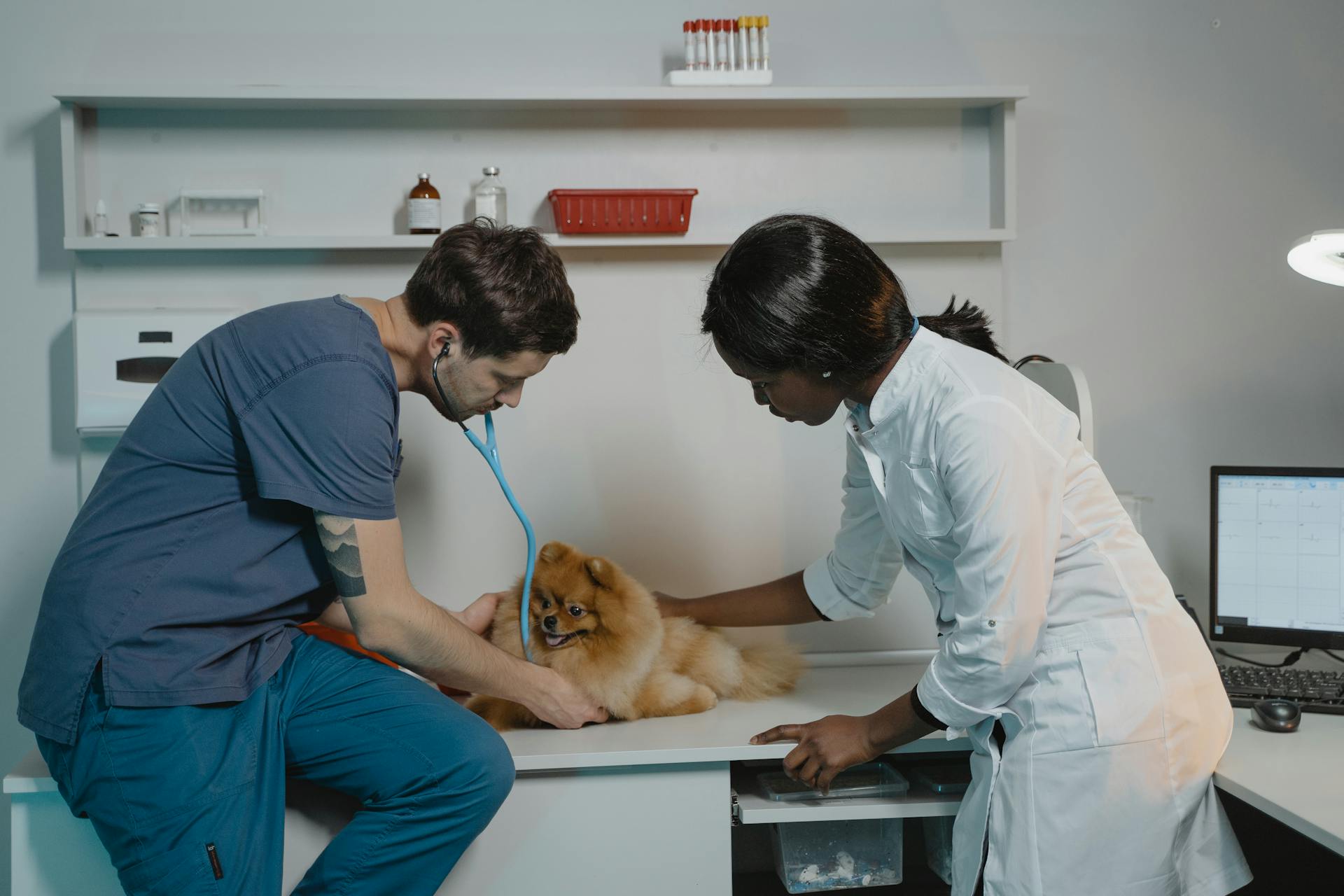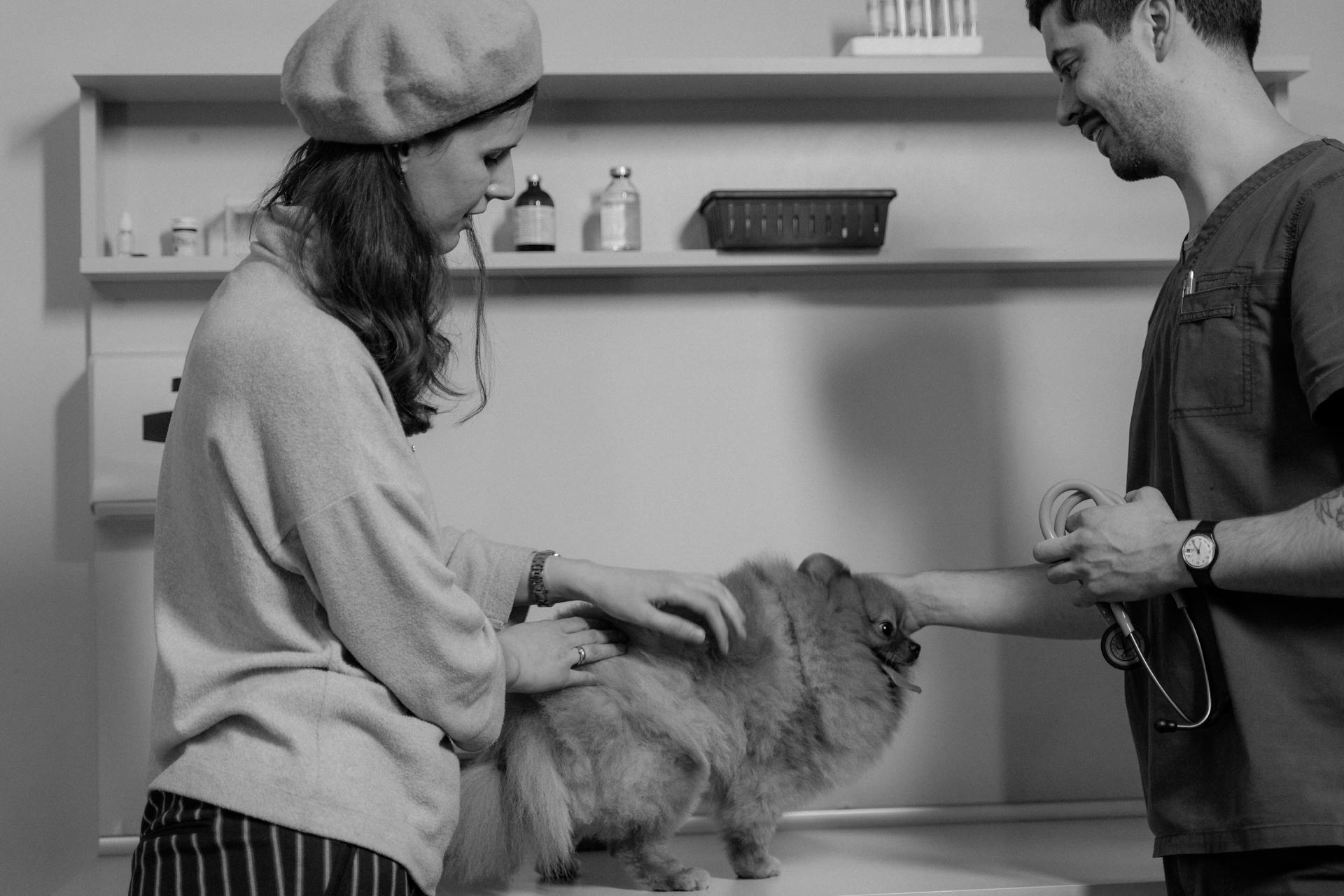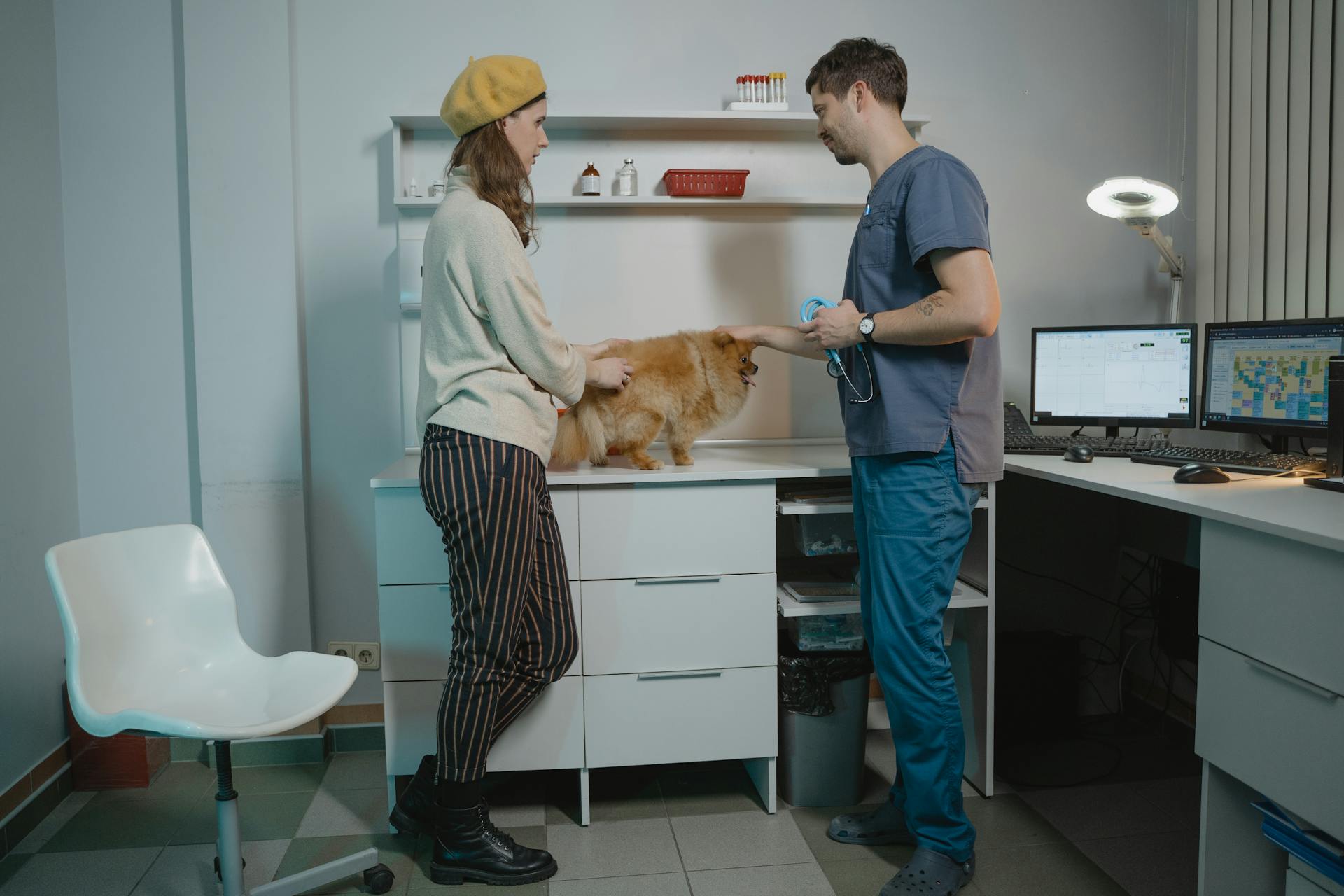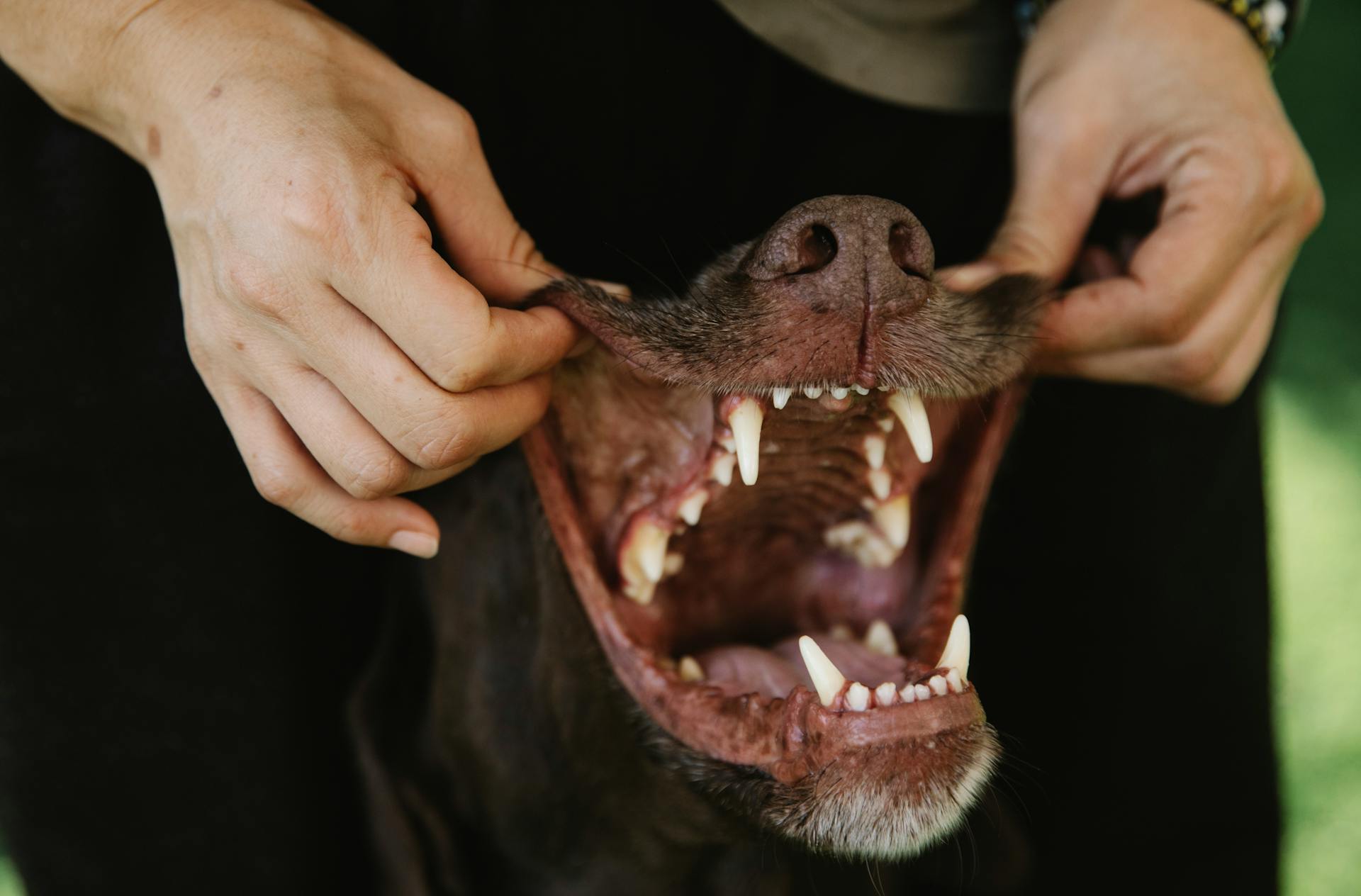
Dog insurance can be a lifesaver for pet owners, but it can be overwhelming to navigate the options. Most dog insurance policies require a deductible, which is the amount you pay out of pocket before the insurance kicks in.
Typically, the deductible ranges from $50 to $1,000 per year, depending on the policy and provider. For example, some policies may have a $250 deductible for accidents and a $500 deductible for illnesses.
As a pet owner, it's essential to understand the different types of coverage available, including accident-only, accident and illness, and wellness plans. Accident-only policies cover unexpected injuries or accidents, while accident and illness policies cover both unexpected events and chronic conditions.
Most policies have a maximum payout limit, which varies depending on the provider and policy. This means that even with insurance, you may still have to pay some out-of-pocket costs for your dog's care.
Types of Coverage
Pet insurance comes in various forms to suit different needs and budgets. Accident-only coverage is the most basic type, designed to cover unexpected accidents like broken bones or swallowed objects. This type of coverage is usually the cheapest option.
Accident-and-illness coverage, on the other hand, provides more comprehensive protection, including both accidents and illnesses like cancer, arthritis, or allergies. Many insurance companies offer this type of coverage, with some even allowing you to add a wellness plan for routine care.
You can also opt for a wellness plan as a standalone policy or add it to your existing coverage. These plans typically cover basic care, such as annual exams, vaccinations, and bloodwork. Some insurance companies, like Lemonade and Metlife Pet Insurance, offer wellness plans as part of their standard policies.
Here's a breakdown of the types of coverage you can expect from different insurance companies:
Keep in mind that not all insurance companies offer all three types of coverage, so be sure to research and compare policies before making a decision.
How It Works
Here's a brief overview of how dog insurance works.
Following your dog's accident, injury, or illness, pet insurance typically kicks in. This is usually after you've paid your premium and met any applicable deductible.
The standard procedure for how pet insurance works is that it covers unexpected veterinary expenses. You'll need to follow the procedure outlined in your policy to get reimbursed for your dog's care.
The Basics

Pet insurance is designed to help cover the costs of veterinary care for your pet.
Following an accident, injury, or illness, pet insurance works by reimbursing you for eligible expenses. This reimbursement is usually a percentage of the total cost, as specified in your insurance policy.
Most pet insurance policies require you to pay a deductible, which is a set amount you pay out of pocket before the insurance kicks in. This deductible can vary depending on the policy and provider.
After paying the deductible, the insurance company will reimburse you for a portion of the remaining expenses, based on the policy's coverage and limits.
Work?
Pet insurance is a great way to ensure your furry friend gets the care they need without breaking the bank. With pet insurance, you can submit your eligible expenses as a claim after your vet visit.
You can use any licensed vet, including specialty and emergency clinics, to get the care your pet needs. This means you have flexibility and peace of mind knowing you can take your pet to the vet you trust.

To get started with pet insurance, you'll need to review your policy to see what's covered and what's not. Comprehensive plans that cover accidents and injuries often require a deductible before your coverage kicks in.
Meeting that deductible will depend on the specifics of your policy, but it's a small price to pay for the peace of mind that comes with knowing your pet is protected.
How Much Cost?
The cost of dog insurance can vary depending on several factors, including the type of plan, pet breed, pet age, annual coverage limit, and deductible.
You can expect to pay a monthly premium ranging from $21.97 to $102.59, depending on the provider and the specifics of your dog's situation. For example, a policy with a $5,000 annual coverage limit from the ASPCA might cost $21.97 per month for a dog, while a policy with no annual limit from Trupanion might cost $102.59 per month.
The average monthly premium for a dog in 2023 was $56.30 for an accident-and-illness coverage plan, according to the North American Pet Health Insurance Association (NAPHIA).
A comprehensive accident and illness plan from Pets Best allows you to choose what percentage of your eligible vet bills you want to be reimbursed for, as well as your pet insurance deductible amount.
Here's a breakdown of the average monthly premiums for dogs and cats in 2023, as reported by NAPHIA:
Policy and Coverage
Pet insurance policies can be categorized into three main types: accident-only, accident and illness, and wellness. Accident-only plans only provide reimbursement for emergency care related to accidents.
Accident and illness plans, on the other hand, provide coverage for both accidents and unexpected illnesses. This type of plan won't cover preventive care or pre-existing conditions.
Some accident and illness pet insurance plans cover hip dysplasia, but not all plans do. It's also common for pet insurance plans to have a waiting period before you can use the benefits for hip dysplasia.
Here are the typical coverage areas for pet insurance plans:
- Unexpected injuries/accidents (like foreign object ingestion, broken bones, and more)
- Unexpected illnesses (like cancer, glaucoma, hip dysplasia, parvovirus, and more)
- Surgery (like cruciate ligament tears, cataracts, and more)
- Medication
- Tests/diagnostics (like X-rays, blood tests, MRIs, and more)
- Emergency exam fees
The annual coverage limit is the maximum amount of money your insurance provider will pay for all medical services for the year.
Wellness Plans
Wellness plans are a type of pet insurance that provides coverage for basic care, such as routine veterinary exams, vaccines, medications, and dental care. This policy is sometimes sold as an add-on to an accident-only or accident and illness policy.
Premiums for some wellness plans are less than $20 or $30 a month, making them a relatively affordable option. Since wellness plans cover routine care services your pet will most likely need, you’ll actually use the coverage.
These plans do not generally cover accidents, injuries, or illnesses. This is in contrast to accident-only plans, which only cover treatment for accident-related injuries, and comprehensive plans that cover both accidents and illnesses.
Some pet insurance companies, like Lemonade and Metlife Pet Insurance, offer wellness plans as an add-on to their policies. This can be a great option if you want to budget for routine care and unexpected accidents or illnesses.
Here are some examples of pet insurance companies that offer wellness plans:
Note that not all pet insurance companies offer wellness plans, so be sure to check with your provider to see what options are available.
Choosing the Right Policy

Choosing the right policy can be a daunting task, but understanding the basics can make it more manageable. Consider the type of coverage you need, such as accident-only or accident and illness plans.
Accident and illness plans provide comprehensive protection for accidents and illnesses, including conditions like cancer, hereditary conditions, arthritis, and hypothyroidism. They also cover the cost of a veterinary exam, medications, hospitalization, and surgery.
When comparing policies, think beyond cost alone and consider coverage limits, deductible options, and available reimbursement rates. You might find that it's worth paying a little more per month for a policy that offers more coverage and has a lower deductible.
Pre-existing conditions are rarely covered by pet insurance, but some companies may cover curable pre-existing conditions. If your pet has a health condition, it's essential to ask the insurance company whether they will be covered before taking out a policy.
Some pet insurance companies offer optional Preventive Care plans that can help cover costs related to proactive care, such as vaccinations, parasite treatment and prevention, dental cleaning, and more.

Here's a summary of what to consider when choosing a policy:
- Accident-only plans cover only emergency care related to accidents
- Accident and illness plans cover both accidents and unexpected illnesses
- Wellness plans cover routine care, such as annual exams, vaccinations, bloodwork, and dental cleanings
- Some companies offer additional coverage for alternative therapies, behavioral modification, and other services
Ultimately, the right policy for you will depend on your pet's specific needs and your budget. Take the time to research and compare policies to find the one that best fits your situation.
Coverage Start Time
Coverage starts at different times depending on the type of claim. MetLife Pet offers a 0-day waiting period for accidents.
If you're purchasing an optional Preventive Care plan, the waiting period is 14 days. This is a standard waiting period for illnesses.
Most insurance plans, including pet insurance, have a waiting period before coverage begins. This is a normal part of the insurance process.
Deductibles and Expenses
A deductible is the amount of money you must pay out of pocket when filing a claim. For example, if you make a claim for a $1,000 vet bill and your deductible is $500, your insurance will reimburse you the remaining $500.

You can choose a deductible when taking out a pet insurance policy, and it's essential to consider your budget and your pet's unique needs. Choosing a low deductible means paying less out of pocket when making a claim, but your premiums will be higher.
A higher deductible usually results in lower premiums and paying a larger chunk of the bill if your pet is injured or becomes ill. This is because the insurance provider will only reimburse you after you've paid the deductible.
Most pet insurance policies have a deductible, which typically ranges from $100 to $1,000. Higher and lower deductibles may be available depending on the insurer.
If your pet insurance plan covers 90% of your eligible vet bills and your pet's first eligible treatment is $500, your pet insurer will reimburse you $450, minus your deductible. This means you'll need to pay the deductible amount out of pocket before receiving reimbursement.
You'll pay the veterinarian directly and file a claim with your pet insurer for each treatment or procedure. Your insurer will evaluate your claim and deposit the funds you qualify for into your bank account or send you a check.
The size of your deductible depends on the policy plan you choose, and some insurers, like MetLife Pet, offer a wide range of deductible options to fit your budget.
Claims and Reimbursement

Filing a claim with your dog insurance provider is a relatively straightforward process. You'll need to pay the veterinarian directly and submit a claim within 60 to 270 days after treatment.
You can file a claim through various methods, including email, mail, fax, online portals, or mobile apps. It's essential to save all receipts and documentation from your vet appointment, as your insurance company may need this information to process your claim.
Reimbursement typically occurs within 5 to 9 days after submitting a claim, and you'll receive payment via check or direct bank deposit. Some insurance companies may even pay the veterinarian directly.
Step 5: File Claim & Get Reimbursed
You'll need to file a claim with your pet insurance provider within 60 to 270 days after treatment to get reimbursed for covered expenses.
Be sure to save all receipts and documentation from your vet appointment, as insurance companies may need this information to process your claim.
Policyholders can usually file claims through email, mail, fax, online portals, or mobile apps, depending on the insurance provider.
After submitting a claim, you'll typically be reimbursed within 5 to 9 days, with the payout offsetting the cost of vet bills.
Insurance companies may pay the veterinarian directly, or reimburse you via check or direct bank deposit, depending on the policy terms.
If your claim is approved, you'll be reimbursed at the rate set in your policy, up to the annual or lifetime limit, after your deductible is met.
Cover All Expenses?
Pet insurance can be a lifesaver, but it's essential to understand what expenses are covered and which ones aren't. Some pet insurance companies provide comprehensive coverage for various medical expenses, but not everything is covered.
Most pet insurance policies cover accidents, illnesses, and diagnostic testing, but routine care, vaccines, and pre-existing conditions are usually not covered. Accident-only plans, for example, only provide reimbursement for emergency care related to accidents, while accident-illness plans cover both accidents and unexpected illnesses.
Readers also liked: Dog Flea Treatment Not Working

The type of plan you choose will determine what expenses are covered. Here's a breakdown of what pet insurance typically covers:
- Unexpected injuries/accidents (like foreign object ingestion, broken bones, and more)
- Unexpected illnesses (like cancer, glaucoma, hip dysplasia, parvovirus, and more)
- Surgery (like cruciate ligament tears, cataracts, and more)
- Medication
- Tests/diagnostics (like X-rays, blood tests, MRIs, and more)
- Emergency exam fees
Some pet insurance plans also cover alternative therapies, behavioral modification, hospital boarding, lost pet advertising/reward, nursing/whelping, chiropractic care, acupuncture, hydrotherapy, and more. However, it's crucial to review your policy to see what specific expenses are covered and what's not.
Visit the Vet
Visiting the vet is a crucial part of your pet's healthcare, and with pet insurance, you can benefit from coverage at any licensed vet clinic or animal hospital in the U.S. Some providers even cover your pet when traveling outside the country.
You'll need to pay for the visit upfront at the time of service, which counts toward your deductible. This means you'll need to cover the cost of the visit yourself before submitting a claim to your insurance provider.
Most insurers impose waiting periods for each type of claim that the policy covers. Illnesses typically have a longer waiting period, usually two weeks, compared to accidents, which have a waiting period of several days.
The longest waiting periods are usually reserved for specific conditions like orthopedic problems and cruciate ligament issues, requiring six months or more before coverage begins.
To help you navigate the waiting periods, here's a quick breakdown:
Keep in mind that pre-existing conditions are not usually covered, so it's essential to review your policy and understand what's included and excluded.
What Isn't Covered
Pet insurance can provide financial protection for your furry friend in case of unexpected medical expenses, but it's essential to understand what's not covered.
Pre-existing conditions are typically not covered by pet insurance policies, which means if your dog has a medical condition before you purchase the policy, it won't be covered.
Routine grooming, such as haircuts, baths, and nail trimmings, is not typically covered by pet insurance policies.
Training classes and behavior modification programs are also not usually covered, as they are considered the owner's responsibility.
Breeding-related expenses, including fertility treatments, artificial insemination, or stud fees, are generally not covered by pet insurance policies.
Explore further: Shock Collar Not Working on Dog
Cosmetic or elective procedures, such as ear cropping or tail docking, are not considered medical care and therefore are not covered.
Preventative care, such as annual check-ups, vaccinations, and dental cleanings, is often not covered by standard pet insurance policies.
Here's a summary of common exclusions:
- Pre-existing conditions
- Routine care/Wellness exams
- Preventative care
- Spay/Neuter
- Vaccination
- Pregnancy and/or birth
- Cosmetic and elective procedures
- Preventable diseases
- Bilateral conditions
Getting Started
To get started with dog insurance, you'll need to quote from a variety of insurance companies, providing details about your dog, such as their name, age, breed, and gender. You'll also need to provide some basic information about yourself, including your name and address.
You'll need to disclose any pre-existing conditions your dog has, which are medical conditions that existed before your policy start date and won't be covered by the plan. Some insurers require a checkup and waiting period before coverage begins.
The waiting period varies by state, insurer, and coverage type, but it's usually a few weeks for illness coverage and a few days for accident coverage.
Frequently Asked Questions
What is a disadvantage of pet insurance?
A disadvantage of pet insurance is that you must pay veterinary expenses upfront, with reimbursement later. Additionally, some health issues are not covered, and pre-existing conditions are often excluded.
How does pet insurance work when you go to the vet?
When you take your pet to the vet, you pay the bill upfront and then submit a claim to get reimbursed for the costs minus the deductible and co-pay. This process helps you cover unexpected vet expenses and keep your pet healthy.
What are the three types of pet insurance?
There are three main types of pet insurance: accident-only, accident and illness, and wellness coverages, each offering varying levels of service and price. Understanding the differences between these types is key to finding the right policy for your pet.
Sources
- https://time.com/personal-finance/article/how-does-pet-insurance-work/
- https://www.metlifepetinsurance.com/how-pet-insurance-works/
- https://time.com/personal-finance/article/what-does-pet-insurance-cover/
- https://www.pawlicy.com/blog/what-is-pet-insurance/
- https://www.progressive.com/answers/pet-insurance-101/
Featured Images: pexels.com


